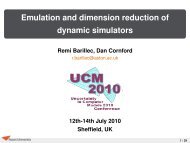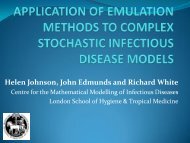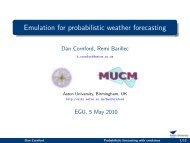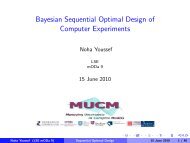Projected Sequential Gaussian Processes: A C++ tool for ... - MUCM
Projected Sequential Gaussian Processes: A C++ tool for ... - MUCM
Projected Sequential Gaussian Processes: A C++ tool for ... - MUCM
Create successful ePaper yourself
Turn your PDF publications into a flip-book with our unique Google optimized e-Paper software.
<strong>Projected</strong> <strong>Sequential</strong> <strong>Gaussian</strong> <strong>Processes</strong>: A <strong>C++</strong> <strong>tool</strong> <strong>for</strong> interpolation of heterogeneous data sets 5<br />
ical integration. In this work we adopt a maximum (marginal) likelihood framework <strong>for</strong><br />
parameter inference.<br />
Large sizes of the datasets also present a major obstacle when likelihood-based spatial<br />
interpolation methods are applied. In terms of memory and processor computational requirements<br />
scale quadratically and cubically respectively. Typically, computation with no<br />
more than a few thousand observations can be achieved using standard likelihood based<br />
spatial interpolation models (Cressie, 1993) in reasonable time. The main computational<br />
bottleneck lies in the need to invert a covariance matrix of the order of the number of observations.<br />
For prediction with fixed hyper-parameters this is a one-off cost and can be approximated<br />
in many ways, <strong>for</strong> example using local prediction neighbourhoods which introduce<br />
discontinuities in the predicted surface. For hyper-parameter estimation matrices<br />
must be inverted many times during the optimisation process (Rasmussen and Williams,<br />
2006, chapter 5). The most common solution to the hyper-parameter estimation problem<br />
adopted in geostatistics is to use a moment based estimator, the empirical variogram, and<br />
fit the parametric model to this (Journel and Huijbregts, 1978; Cressie, 1993), however<br />
these methods will not work when we assume that the field of interest, f , is not directly<br />
observed, but rather there exists a sensor model such that yi = h[ f (xi)] + εi. The use of<br />
such a latent process framework corresponds very closely to the model-based geostatistics<br />
outlined in Diggle and Ribeiro (2007).<br />
Instead of employing a batch framework where all the observations are processed at once,<br />
in this work we consider a sequential algorithm to solve the previously mentioned challenges.<br />
There are other advantages that can be obtained by using sequential algorithms.<br />
Processing of the data can begin be<strong>for</strong>e the entire dataset has been collected. An example<br />
might be a satellite scanning data across the globe over a time period of a few hours.<br />
As the data is collected, the model is updated sequentially. This can also be of use in<br />
real-time mapping applications where data might arrive from a variety of communication<br />
systems all with different latencies. The sequential approach we employ is described in<br />
detail in Section 4. The main idea is that we sequentially approximate the posterior process,<br />
eq. (2), by the best approximating <strong>Gaussian</strong> process as we update the model one<br />
observation at a time. In order to control the computational complexity we have adopted<br />
a parametrisation <strong>for</strong> the approximate posterior process which admits a representation in<br />
terms of a reduced number of active points. Thus the name projected, sequential <strong>Gaussian</strong><br />
process (psgp) <strong>for</strong> the library.<br />
We have chosen to implement our algorithm using <strong>C++</strong> to ensure that program execution<br />
is efficient and can be optimised where required. A web processing service interface to<br />
the psgp library can be accessed from the INTAMAP project web site 1 .<br />
We start in Section 3 by discussing large datasets and how these can be treated using a<br />
number of different approximations. In Section 4 we introduce the model parameterisation,<br />
present the sequential algorithm updates the parameterisation given observations<br />
and outline hyper-parameter estimation. An overview and discussion of design principles<br />
used in our implementation is presented in Section 5. Section 6 shows how the software<br />
can be applied to synthetic and real-world data. Section 7 contains a discussion of<br />
the algorithm per<strong>for</strong>mance and gives conclusions. The paper builds upon Corn<strong>for</strong>d et al.<br />
(2005) and Csató and Opper (2002) by allowing more flexible approaches to sensor models<br />
and dealing in more detail with algorithmic and implementation details and practical<br />
deployment of the new <strong>C++</strong> psgp library.<br />
1 http://www.intamap.org






